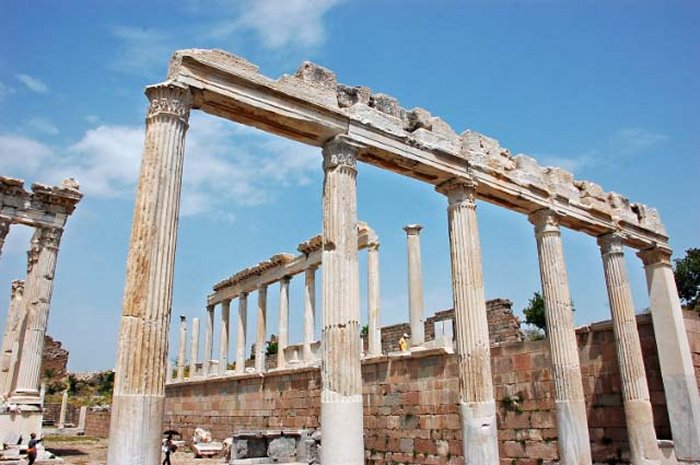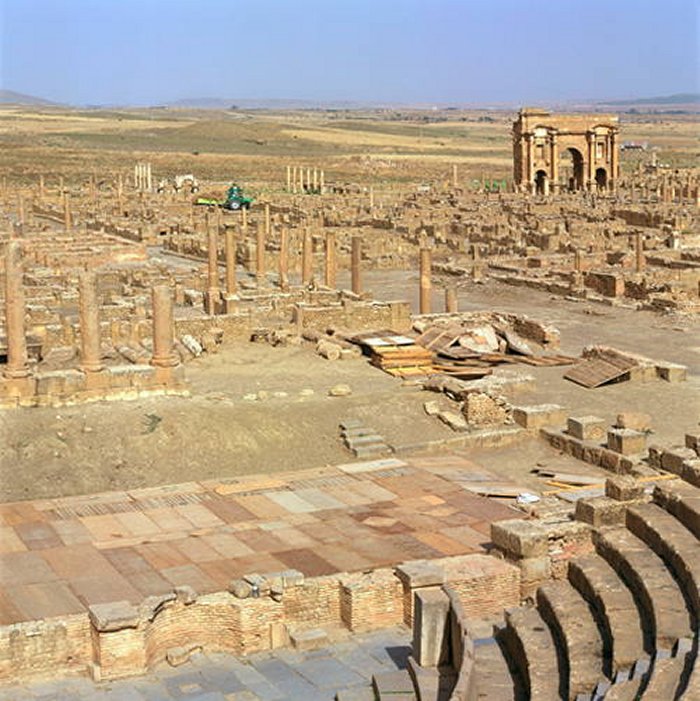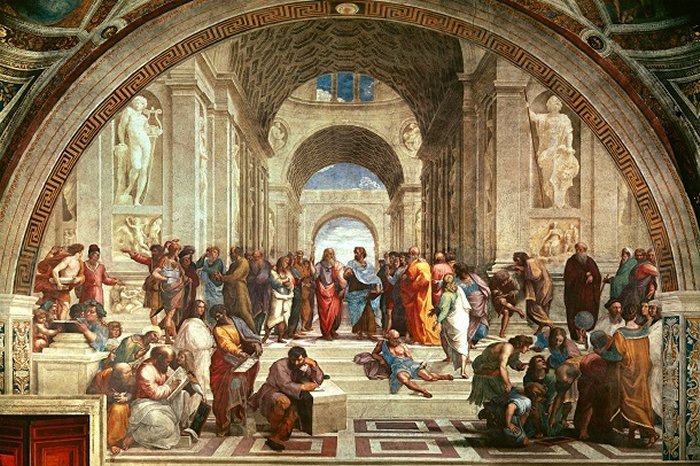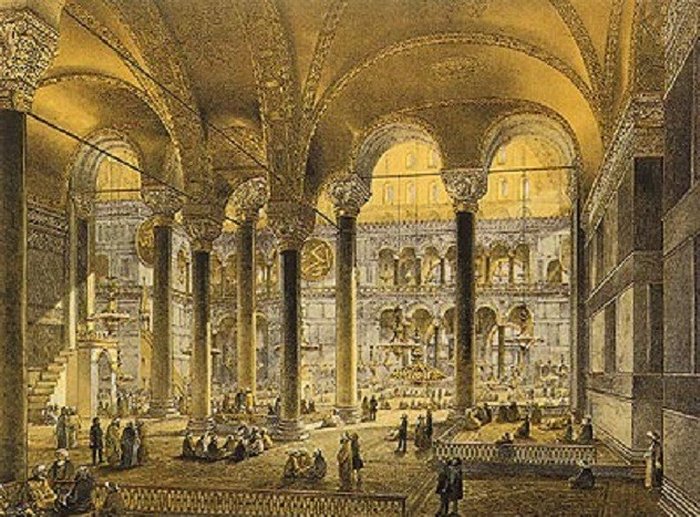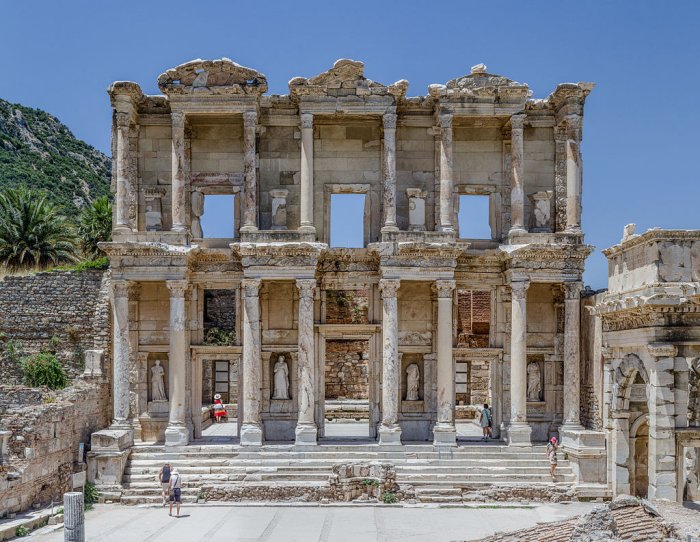10 Magnificent Ancient Libraries
AncientPages.com - Long ago, there were many magnificent ancient libraries filled with priceless books and scrolls. Today, the Great Library of Alexandria is the most famous ancient library, but it is far from the only one that contained valuable knowledge. There were several ancient libraries across the world that are now gone, but should not be forgotten.
In this top list we take a closer look at some of the most amazing ancient libraries of all times.
1. The Library Of Pergamum
The library of Pergamum, located in what today is known as Bergama in Turkey was founded around 197-159 BCE.
Its construction is associated with the rule of king Eumenes II, king of Pergamon and a member of the Attalid dynasty.
There have been several speculations why the library was constructed. Some historians maintain the library was indented to compete with the Great Library of Alexandria. Other scholars think it was an independent effort.
According to the writings of Plutarch, the library was said to library said to house approximately 200,000 volumes and it was one of the most important libraries in ancient times.
No index or catalog of the holdings at Pergamum exists today, making it impossible to know the true size or scope of this collection. Historical accounts claim that the library possessed a large main reading room, lined with many shelves. An empty space was left between the outer walls and the shelves to allow for air circulation. This was intended to prevent the library from becoming overly humid in the warm climate of Anatolia and can be seen as an early attempt at library preservation. Manuscripts were written on parchment, rolled, and then stored on these shelves. A statue of Athena, the goddess of wisdom, stood in the main reading room.
The end came after the library was damaged by fire. Legend has it that Mark Antony, a Roman politician and general later gave Cleopatra all of the 200,000 volumes at Pergamum for the Library of Alexandria as a wedding present, emptying the shelves and ending the dominance of the Library at Pergamum.
Another account states that Mark Antony bequeathed the collection to Cleopatra as a reimbursement for the conflagration of the Library of Alexandria by Julius Caesar.
2. Library Of Ashurbanipal
The oldest surviving royal library in the world is that of Ashurbanipal, King of Assyria (668-around 630 BC). British Museum archaeologists discovered more than 30,000 cuneiform tablets and fragments at his capital, Nineveh (modern Kuyunjik).
Alongside historical inscriptions, letters, administrative and legal texts, were found thousands of divinatory, magical, medical, literary and lexical texts.
This treasure-house of learning has held unparalleled importance to the modern study of the ancient Near East ever since the first fragments were excavated in the 1850s.
King Ashurbanipal was the ruler of ancient Assyria, famous for his military accomplishments. However, Ashurbanipal’s establishment of a great library in the city of Nineveh, is considered of far greater importance.
Ashurbanipal’s library was not the first library of its kind but it was one of the largest and one of the ones to survive to the present day.
3. The Library At Timgad
When the the Library at Timgad was built remains unknown, but it was a gift to the Roman people by Julius Quintianus Flavius Rogatianus. The library occupied a rectangle eighty-one feet (24.69 meters) long by seventy-seven feet (23.47 meters) wide.
Its architecture of was not especially remarkable, but it was a great historical importance as it showed the presence of a fully developed library system in this Roman city, indicating a high standard of learning and culture. While there is no evidence as to the size of the collection the library harbored, it is estimated that it could have accommodated 3,000 scrolls.
4. Theological Library Of Caesarea Maritima
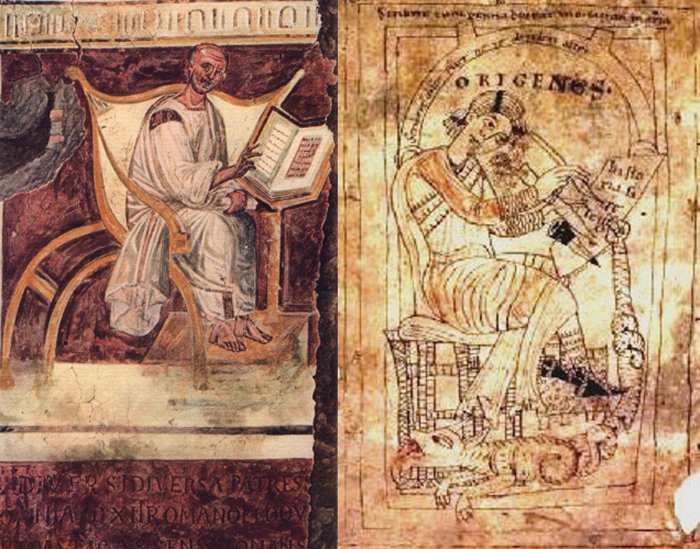
Origen, an avid collector of Christian books helped create the Library of Caesarea containing more than 30,000 manuscripts
Caesarea is located on the Mediterranean coast, about midway between Haifa and Tel Aviv. The Church Father Origen (184/185 – 253/254) founded a Christian academy in the city, which included a library of 30,000 manuscripts. The Theological Library of Caesarea Maritima, or simply the Library of Caesarea, was the library of the Christians of Caesarea Maritima.
The library served as a Christian center of education and scholarship with a vast collection of Christian and Jewish texts, as well as a large collection of Greek literature, primarily philosophical and historical works. Several historical personalities such as Gregory Nazianzus, Basil the Great, Jerome came to study at the library. According to the Hebrews the Gosple was one of the library’s many treasures.
The collections of the library suffered during the persecutions under the Emperor Diocletian, but were repaired subsequently by bishops of Caesarea. Later it was destroyed by the Arabs in the 7th century.
Unfortunately, no catalogue of the library’s collection survived.
5. Villa Of The Papyri And The Herculaneum Library
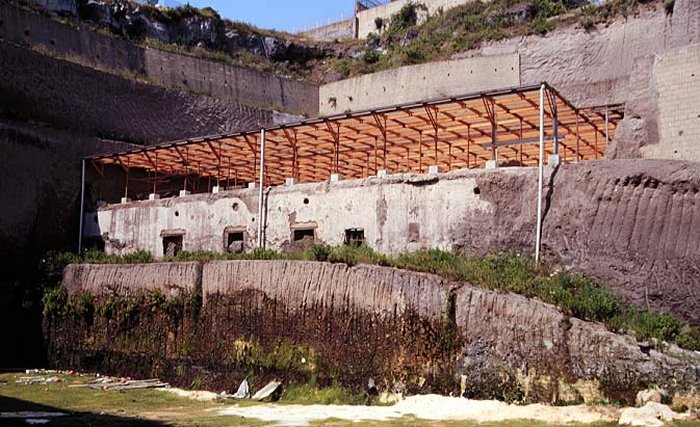
Villa of the Papyri contaiend a huge ancient library filled with valuable scrolls. Image credit: Wikipedia
The Villa of the Papyri is a private house in the ancient Roman city of Herculaneum. It contains the only library to have survived from the classical world. The Villa dei Papiri is thought to have been built by Julius Caesar’s father-in-law, Lucius Calpurnius Piso Caesoninus, a wealthy statesman who was a consul of the Roman Republic in 58 B.C. The huge house, at least three stories tall, sat beside the Bay of Naples, which at that time reached five hundred feet farther inland than it does today.
On February 5, 62 AD Pompeii, an ancient Roman town-city near modern Naples, was at the epicenter of an earthquake. The earthquake was approximately 7.5 in magnitude and may have been a precursor to the eruption of Mount Vesuvius in AD 79 that destroyed Pompeii and Herculaneum.
The catastrophic effects almost destroyed the city. The Villa of the Papyri was first discovered by tunneling in the 18th century. At least eight hundred scrolls were uncovered. The scrolls constitute the only sizable library from the ancient world known to have survived intact. Some were found stacked on shelves in a small room; others were elsewhere in the villa, packed in capsae, traveling boxes for the scrolls, presumably in preparation for flight.
6. The Ancient Nalanda Library
The Nalanda University in India is the world’s oldest university. By the time the first European university was established in Bologna in 1088, Nalanda had been providing higher education to thousands of students from Asian countries for more than six hundred years.
The university was an architectural and environmental masterpiece. It had eight separate compounds, 10 temples, meditation halls, classrooms, lakes and parks.
It had a nine-story library where monks meticulously copied books and documents so that individual scholars could have their own collections.
Nalanda University was celebrated as the world’s largest collection of Buddhist literature, supportive followers admiring the university’s greatness and new philosophies.
7. The Library Of Aristotle
The library of Aristotle is what many believe to be the first private library of the ancient world. Aristotle, pne of the most recognized philosophers of all time, opened the Lyceum - a gymnasium and a library, where many of his teachings and the works of his students were at present.
Writing more than 300 years after Aristotle's death, in the first decades of the first century CE, the geographer Strabo provided one of the most detailed early accounts in his Geographia XIII, 1, 54-55, stating, among other things that Aristotle was "the first man, so far as I know, to have collected books and to have taught the kings in Egypt how to arrange a library."
According to Strabo, Aristotle bequeathed his own library to Theophrastus to whom he also left his school. Aristotle heard about the jealously the Attalid kings who ruled the city at the time. The kings were searching for books to build up the library in Pergamum. It was then decided that the book collection of Aristotle should be hidden undergound. The books were damaged by moisture and moths, their descendants sold them to Apellicon of Teos for a large sum of money.
8. The Imperial Library Of Constantinople
There is not much information about the Imperial Library of Constantinople, which in itself makes it a bit of a mystery. Around 357 CE Constantius II the Byzantine Emperor was aware that early texts in his care which were written on papyrus scrolls were deteriorating.
He then decided to create the Imperial Library of Constantinople so that many Judaeo-Christian scriptures could be copied from papyrus to parchment or vellum. Though Constantius II was only interested in preserving scriptures, the Imperial Library had housed knowledge of the ancient Greeks and Romans for hundreds of years. In fact the majority of Greek classics that we know today have come from Byzantine copies originating from the Imperial Library of Constantinople.
9. The Great Library Of Alexandria
The Great Library of Alexandria is the most famous library in classical antiquity. Over the years it has gained a mythical status as a ‘universal’ library where all scholars of the ancient world could come and share ideas. The library was located within the grounds of the Royal Palace in Alexandria a port city in northern Egypt and was built around 295 BCE by Ptolemy I.
See also:
10 Ancient Fortresses Of Historical Importance
The library of Alexandria did not only hold its own valuable scriptures, but also the 200 000 volumes from the library of Pergamum. The library was a complex with shrines dedicated to each of the nine muses, lectures areas, observatories, a zoo and living quarters. It was thought to house the works of great scholars and writers including Homer, Plato and Socrates. The Alexandrian library was destroyed on several occasions throughout the centuries. The perpetrators were Caesar in 48 BC; Emperor Aurelian in 270 AD, Pope Theophilus in 391 AD and finally by the Muslims in 642 AD.
10. The Library Of Celcus
The library of Celsus is an ancient Roman building in Ephesus, Anatolia, now part of Selçuk, Turkey. It was built in honor of the Roman Senator Tiberius Julius Celsus Polemaeanus (completed in 135 AD) by Celsus' son, Gaius Julius Aquila (consul, 110 AD). The library was built to store 12,000 scrolls and to serve as a mausoleum for Celsus, who is buried in a crypt beneath the library.
Copyright © AncientPages.com All rights reserved. This material may not be published, broadcast, rewritten or redistributed in whole or part without the express written permission of AncientPages.com
Expand for referencesReferences:
History of Information – Library of Pergamun
Wikipedia – Library of Pergamun
MessageToEagle.com - Assyrian King Ashurbanipal’s Great Library With Thousands Of Cuneiform Tablets
MessageToEagle.com - Ancient City Great Of Timgad And The Magnificent Arch Of Trajan
MessageToEagle.com - Herculaneum Time Capsule: Ancient Scrolls With Secrets Buried Under Volcanic Ash And Stones
The New Yorker – The Invisible Library
AncientPages.com - Nalanda: The Oldest University In The World
History of Information – The Library Of Aristotle
More From Ancient Pages
-
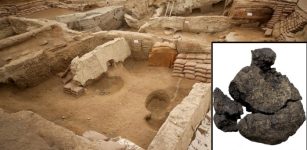 World’s Oldest Bread Found In Neolithic Oven In Çatalhöyük, Turkey
Archaeology | Mar 12, 2024
World’s Oldest Bread Found In Neolithic Oven In Çatalhöyük, Turkey
Archaeology | Mar 12, 2024 -
 Curse Of The Dancer – Mysterious 1,500-Year-Old Tablet Finally Deciphered
Archaeology | Oct 14, 2019
Curse Of The Dancer – Mysterious 1,500-Year-Old Tablet Finally Deciphered
Archaeology | Oct 14, 2019 -
 Lyman Lake Petroglyphs And Famous Kokopelli-Flute Player Left By Ancestors Of The Hopi Indians
Civilizations | Nov 26, 2018
Lyman Lake Petroglyphs And Famous Kokopelli-Flute Player Left By Ancestors Of The Hopi Indians
Civilizations | Nov 26, 2018 -
 Cooking, Roasting And Eating Of Root Plants Is 120,000-Year-Old Habit
Archaeology | Jun 7, 2019
Cooking, Roasting And Eating Of Root Plants Is 120,000-Year-Old Habit
Archaeology | Jun 7, 2019 -
 Saqqara New Discoveries: Fifth Dynasty’s Pyramid Complex That Belonged To Queen Setibhor
Archaeology | Apr 15, 2019
Saqqara New Discoveries: Fifth Dynasty’s Pyramid Complex That Belonged To Queen Setibhor
Archaeology | Apr 15, 2019 -
 New Photos Of The Puzzling 7,000-Year-Old Circular Structure Near Prague And New Attempt To Solve The Neolithic Mystery
Archaeology | Apr 20, 2023
New Photos Of The Puzzling 7,000-Year-Old Circular Structure Near Prague And New Attempt To Solve The Neolithic Mystery
Archaeology | Apr 20, 2023 -
 Precious Ancient Chinese Immortality Suits Made Of Jade
Artifacts | Aug 22, 2015
Precious Ancient Chinese Immortality Suits Made Of Jade
Artifacts | Aug 22, 2015 -
 Mysterious Disappearance Of Philip Christoph Königsmarck – Where Is The Swedish Count Buried?
Featured Stories | Feb 21, 2024
Mysterious Disappearance Of Philip Christoph Königsmarck – Where Is The Swedish Count Buried?
Featured Stories | Feb 21, 2024 -
 Aboriginal Legends Tell Millennia-Old Stories Of Events In The Sky
Myths & Legends | Mar 6, 2015
Aboriginal Legends Tell Millennia-Old Stories Of Events In The Sky
Myths & Legends | Mar 6, 2015 -
 Amrita: Potion Of Immortality Consumed By Gods To Make Them Strong And Immortal
Featured Stories | Apr 5, 2019
Amrita: Potion Of Immortality Consumed By Gods To Make Them Strong And Immortal
Featured Stories | Apr 5, 2019 -
 On This Day In History: Great Fire Of London Ends – On Sep 5/6, 1666
News | Sep 5, 2016
On This Day In History: Great Fire Of London Ends – On Sep 5/6, 1666
News | Sep 5, 2016 -
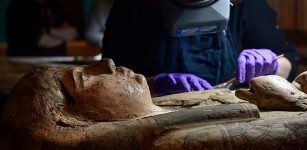 Never-Before-Seen 3,000-Year-Old Paintings Of Egyptian Goddess Amentet Discovered Inside Coffin Of A Mummy
News | Apr 7, 2020
Never-Before-Seen 3,000-Year-Old Paintings Of Egyptian Goddess Amentet Discovered Inside Coffin Of A Mummy
News | Apr 7, 2020 -
 Trung Sisters Of Vietnam: National Heroines That Stood Against Cruel Chinese Occupation Of Their Country
Featured Stories | Apr 29, 2019
Trung Sisters Of Vietnam: National Heroines That Stood Against Cruel Chinese Occupation Of Their Country
Featured Stories | Apr 29, 2019 -
 Gengen Wer – Goose God Who Guarded The Celestial Egg Containing The Life Force In Egyptian Beliefs
Featured Stories | Apr 22, 2021
Gengen Wer – Goose God Who Guarded The Celestial Egg Containing The Life Force In Egyptian Beliefs
Featured Stories | Apr 22, 2021 -
 Steel Was Already Being Used In Europe 2,900 Years Ago – New Study
Archaeology | Mar 1, 2023
Steel Was Already Being Used In Europe 2,900 Years Ago – New Study
Archaeology | Mar 1, 2023 -
 Huge Viking Winter Camp Unearthed In England
Archaeology | May 19, 2017
Huge Viking Winter Camp Unearthed In England
Archaeology | May 19, 2017 -
 Library Of Celsus: Beautiful Classic Monument In Ephesus That Stored 12,000 Scrolls
Civilizations | Nov 14, 2018
Library Of Celsus: Beautiful Classic Monument In Ephesus That Stored 12,000 Scrolls
Civilizations | Nov 14, 2018 -
 Mysterious Great Pyramid Of China: Almost Totally Unknown Even To Most Chinese
Featured Stories | Oct 10, 2015
Mysterious Great Pyramid Of China: Almost Totally Unknown Even To Most Chinese
Featured Stories | Oct 10, 2015 -
 Who Were The First Icelanders?
Archaeology | Jun 4, 2018
Who Were The First Icelanders?
Archaeology | Jun 4, 2018 -
 1,000-Year-Old Bone Skate Found In Moravian City Of Přerov, Czech Republic
Archaeology | Mar 20, 2024
1,000-Year-Old Bone Skate Found In Moravian City Of Přerov, Czech Republic
Archaeology | Mar 20, 2024

